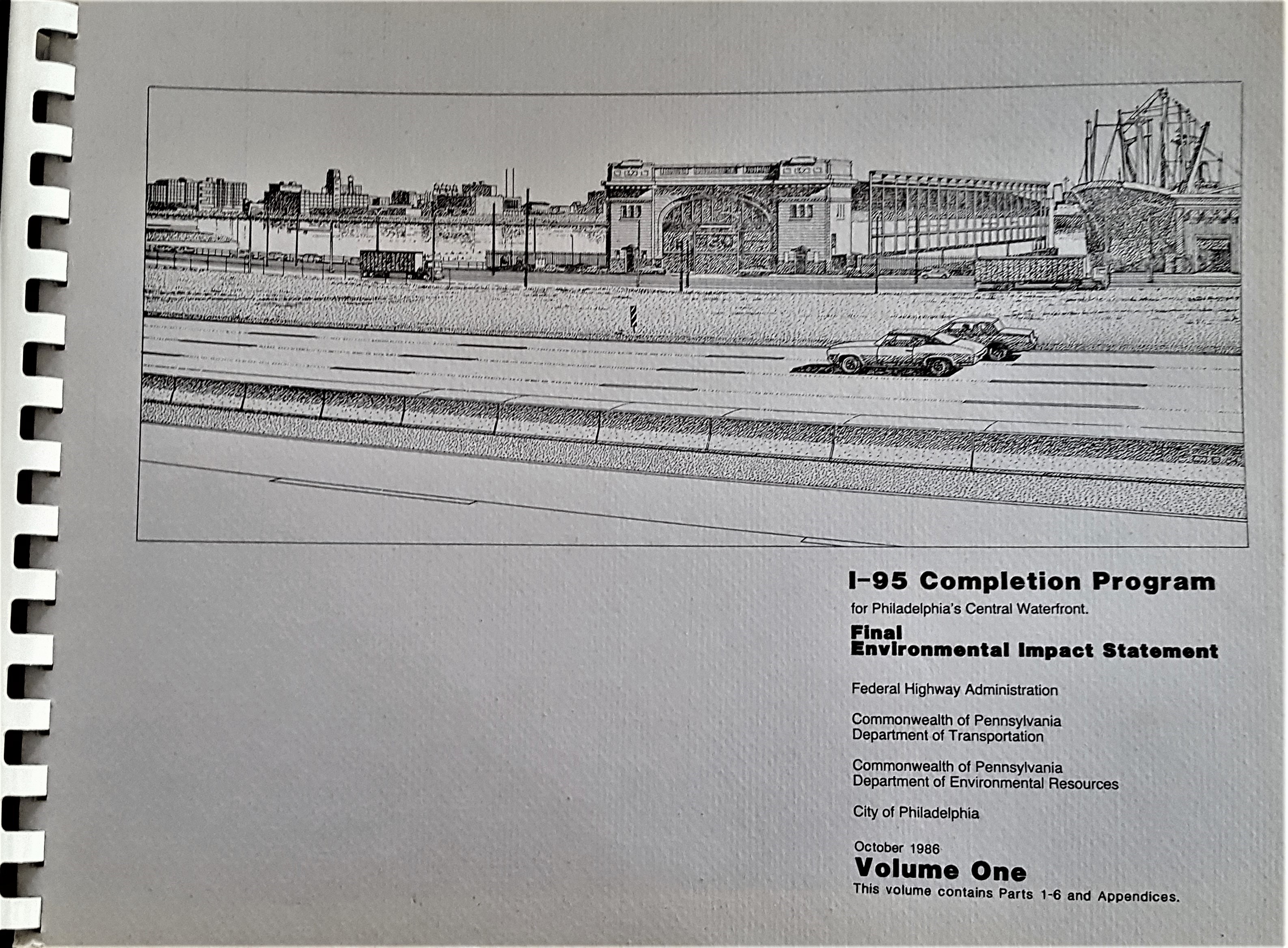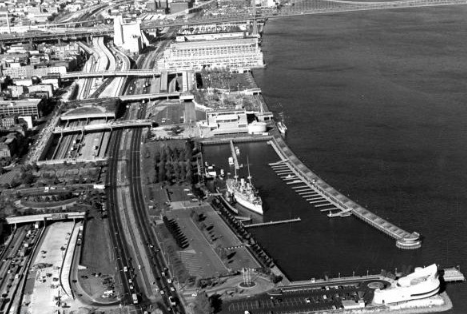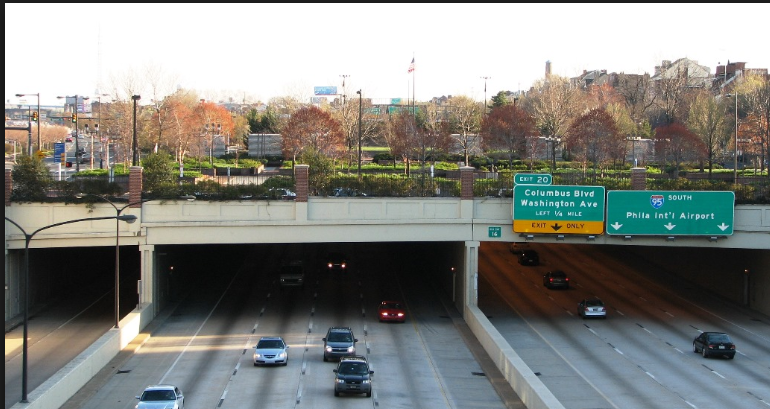But just because the concept was given federal approval did not mean it would suddenly appear. It took until June 1969 for the Pennsylvania House of Representatives to approve the State’s share of the cost, $4.03 million. By the end of 1970 with continuing indecision about the federal government providing its share, Mayor Tate decided to abandon the project. He felt it had to go ahead without a cover; otherwise this missing link in the mostly completed I-95 could not be finished in time for the 1976 Bicentennial celebrations in Philadelphia. Then in February 1971, Secretary of Transportation John Volpe announced that funds could come from the Federal Highway Trust Fund. It took another year for the state Highway Department to approve the cover –five years after the fight had begun.
Meanwhile, opposition had grown to the proposed Crosstown Expressway, planned by Bacon to extend along the south side of the city along South Street. The opponents were finally successful, and the project was dropped in the 1970s; this meant that the on- and off-ramps to and from 1-95 had to be removed and that section redesigned. It took until 1983 to do so and until 1986 for an environmental impact statement to be published, probably one of the first of its kind.
As a result of the opposition to both the Delaware and Crosstown Expressways, Bacon changed his tune, and, as early as 1968, when speaking at a Department of Transportation hearing, he spoke of this citizen resistance to highway plans and said:
“It has already been recognized by Congress in legislative requirements for greater citizen voice in the formation of governmental policy which directly and drastically affects citizens’ lives, notably in the field of housing and urban development. The establishment of similar provisions related to highway design is both timely and appropriate.” (quoted in Gregory Heller, Ed Bacon: Planning, Politics, and the Building of Modern Philadelphia, University of Pennsylvania Press, p. 166)
In March of 1972 when the Browne family moved from Philadelphia to Brussels, Belgium, Stanhope turned over leadership of the Gateway Committee to neighbor and fellow lawyer Harry K. Schwartz, who continued to put pressure on the Department of Highways to complete the cover. After Harry Schwartz went to Washington, DC to work for President Carter, leadership of the committee passed to another lawyer and neighbor, Mark K. Kessler, in 1978. Stanhope, now returned from Brussels, became Honorary Chairman.
Work on the I-95’s Center City section (from the Walt Whitman Bridge to Girard Avenue) began in 1972, while design issues about the cover continued. Following a 1974 consent decree from the U. S. District Court, construction finally began. In November 1976 Pennsylvania Department of Transportation’s Secretary William Sherlock announced that the State would not have the funds to complete the cover: two-and-a-half blocks of the approved six-block cover over the highway had been built in two sections, from Delancey to Spruce to Dock Streets and one-half block south of Chestnut, but there were no funds for filling in the gap or landscaping any of it.
Stanhope sent the following invitation on May 15, 1978:
TO THE MEMBERS OF THE COMMITTEE TO PRESERVE THE NATION’S BIRTHPLACE:
This will confirm that the last meeting of the old committee, and the first meeting of the new committee will be held at 8:00 PM on Monday, May 22, 1978 at my house, 306 South 2nd Street.
The first item of business will be to elect Mark Kessler as new Chairman. The second item of business will be to develop a strategy for making the Commonwealth’s Department of Transportation live up to its promise to complete the cover. The third item will be to develop a list of new people in the neighborhood (or elsewhere) who can help.
Weather permitting, the meeting will conclude with partially-filled glasses of champagne on the partially-landscaped cover, to celebrate our partial victory.
The cover was finally completed in September 1979, nearly fifteen years after the first meeting at the Penn Mutual Building in December 1964.
Issues of the ventilation, design and landscaping of the cover and noise abatement in the adjoining neighborhoods – Queen Village and Old City, where the expressway would rise to be above grade – were finally resolved and compromises made, although the issue of access ramps continued.
An addition to the cover, a pedestrian bridge over I-95 at the foot of Walnut Street connecting to Penn’s Landing was completed in 1991 by PennDOT. It was in the same year that the redesigned ramps were finally completed and opened.
Arrangements were made between the City of Philadelphia and the Pennsylvania Department of Transportation for the maintenance of the edges of the depressed highway in the Center City section of the Delaware Expressway. They were to be managed by the newly-created Interstate Land Management Corp. (ILMC) with landscaping supervision to be provided by the Pennsylvania Horticultural Society. Funds for this function were to be raised by leasing unused parcels for uses such as parking.
Stanhope was very pleased to be one of the speakers at the dedication of the Walnut Street bridge on July 18, 1991. Pennsylvania Secretary of Transportation Howard Yerusalim also spoke and said as part of his remarks:
“The opening of this bridge today and of the startup of ILMC are two major achievements that the communities located along Interstate 95 can rightly be proud of. It took some five years of earnest negotiations, it took a great deal of time and energy, it took a lot of give and take to solve the problem of how to keep the interstate right of way clean, but I believe that everyone here will agree it was well worth it.
And while there may have been some who felt it was impossible to agree on anything concerning I-95, the perseverance of the many people who wanted a resolution to the problem made it possible.”
It had taken over twenty-six years of vision and perseverance on the part of many, many people to finally reach this moment. The cover, even if not nearly as extensive as the Architects Committee and the Gateway envisioned, provides beautiful and meaningful spaces which truly connect the historic city to its waterfront.
Post-script:
For its 50th anniversary in 2010, OPDC, now Central Philadelphia Development Corporation, created a series of videos. One of them, “The Impact of Interstate Highways on Center City,” features the Expressway fight, and Stanhope is interviewed at some length. This video gives an excellent recap of the whole situation. Near the beginning of the film, the voice of Edmund Bacon is heard saying on what sounds like a very old recording: “The automobile must be an invited guest in the city.”
However, following the presentation of a filmed review of his career not long before his death in 2005, Bacon spoke of the Delaware Expressway controversy. He stated to the large crowd in attendance, including the two of us, that he had realized later that he had been mistaken and that it was right that the Delaware Expressway had been depressed and covered. Stanhope was very pleased to hear this admission at last.


